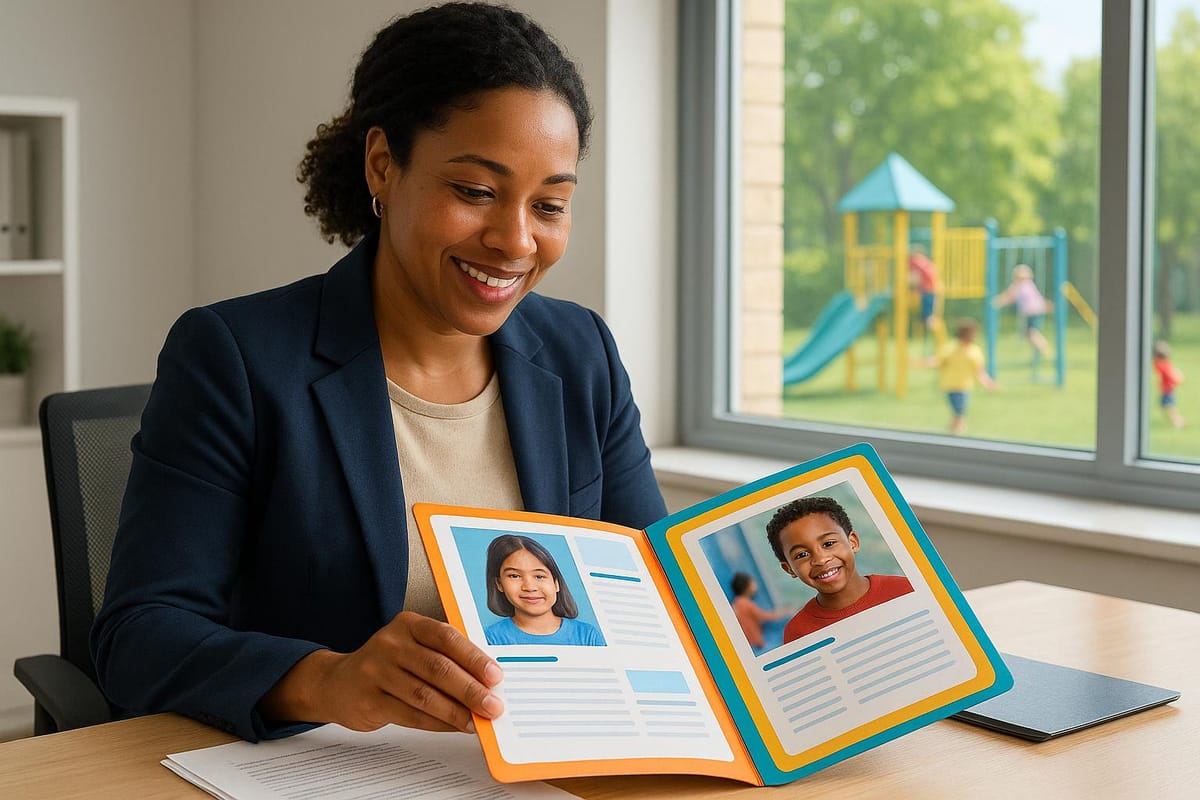Child Protection Officer Role in Sponsorship Programs
Explore the vital role of Child Protection Officers in sponsorship programs, ensuring children's safety and well-being through proactive measures.

Child Protection Officers (CPOs) are essential in ensuring the safety and well-being of children in sponsorship programs. Their work involves safeguarding children from harm, promoting their rights, and fostering trust within communities. Here's a quick breakdown of their role:
-
Core Responsibilities:
- Conduct safety assessments in homes, schools, and communities.
- Educate children and families on recognizing risks and understanding rights.
- Maintain confidential records and report suspected abuse to authorities.
- Train staff and volunteers on child protection policies and practices.
-
Key Contributions:
- Prevent abuse and exploitation by educating families and building community networks.
- Strengthen community trust through respectful dialogue and protective measures.
- Monitor program outcomes using data to ensure effective child safety efforts.
-
Required Qualifications:
- A bachelor's degree in social work or related fields (master’s preferred).
- At least 1-2 years of experience in child welfare or related areas.
- Skills in risk assessment, communication, and case management.
-
Use of Technology:
- Digital tools for case management, communication, and reporting improve efficiency and streamline processes.
CPOs play a critical role in transforming sponsorship contributions into impactful child protection initiatives, ensuring children grow in safe and supportive environments.
«Hannah’s New Job» - Becoming a Child Protection Practitioner in Humanitarian Settings
Main Duties of Child Protection Officers
Child Protection Officers (CPOs) play a crucial role in ensuring the safety and well-being of children in sponsorship programs. Their responsibilities range from direct interactions with children to implementing policies that prioritize protection across the entire program. Every aspect of their work is designed to create a safe and supportive environment for children.
Keeping Children Safe and Healthy
CPOs conduct regular assessments in homes, schools, and communities to evaluate safety and identify potential risks. They closely examine family relationships, community environments, education systems, and health conditions to develop detailed safety profiles. During home visits, they observe how parents and children interact, check living conditions, and look for any signs of abuse, neglect, or exploitation.
In schools, they work hand-in-hand with teachers and administrators to track children’s academic progress, attendance, and social engagement. Additionally, they provide psychoeducation to children and their families, helping them recognize potential dangers and understand their rights within established protection frameworks.
CPOs also focus on empowering families by teaching them how to spot early warning signs of exploitation or abuse. This proactive approach equips children and their caregivers to take preventive measures before situations become critical.
Managing Confidential Records
Maintaining accurate and secure records is a cornerstone of effective child protection. CPOs are responsible for keeping detailed, confidential files for every case, ensuring access is limited to authorized personnel only. These files include sensitive information such as intake forms, risk assessments, and compliance reports, all of which are stored following strict confidentiality guidelines.
To maintain organization and consistency, CPOs use standardized naming conventions for documents. Each case is documented in its own file, while broader child safety materials are kept in separate administrative folders. This clear structure helps streamline case management and ensures important information is readily available when needed.
The documentation process also involves completing detailed child protection reports and adhering to rigorous management standards. CPOs align their practices with the United Nations Convention on the Rights of the Child, balancing confidentiality with a child-focused approach. If there is reasonable suspicion of abuse or neglect, they are legally obligated to report the case to law enforcement authorities.
Training Staff and Partners
CPOs are instrumental in educating staff, volunteers, and partner organizations about child protection policies. They ensure everyone involved in sponsorship programs understands their roles and can identify potential risks. Working closely with program coordinators, CPOs design and deliver training sessions covering policy implementation, risk detection, reporting protocols, and best practices.
As supervisors, CPOs lead social worker teams, conduct performance reviews, and hold regular case management meetings to uphold program quality. They provide ongoing guidance to psychosocial and protection teams, ensuring consistent application of child protection standards. Building strong networks with project partners is another critical aspect of their role, as they facilitate training, share knowledge, and advocate for broader awareness of child protection issues.
CPOs also engage with communities to encourage participation in protection efforts, promote the creation of child-friendly spaces, and support psychosocial initiatives.
"All girls and boys have increased access to child protection services and violence against children is reduced by 2021"
– Save the Children International
How Child Protection Officers Drive Program Success
Child Protection Officers (CPOs) play a crucial role in shaping the success of sponsorship programs by creating systems and partnerships that safeguard and uplift children. Their efforts extend well beyond handling individual cases, as they lay the groundwork for programs that thrive over the long term.
Preventing Abuse and Exploitation
CPOs are at the forefront of protecting approximately 9.14 million sponsored children from harm. They focus on empowering children by educating them about their rights, which helps reduce their vulnerability to exploitation and strengthens program outcomes. Their efforts also include educating families, promoting birth registration to secure legal identities, and working closely with community leaders like teachers, police officers, and healthcare workers. Together, these measures form a comprehensive safety net that not only protects children but also fosters deeper community involvement.
Building Community Trust
After establishing protective measures, CPOs focus on building trust within communities - a critical element for the success of sponsorship programs. Trust acts as the foundation that allows these programs to function effectively, and CPOs are instrumental in earning it. They do so by addressing harmful traditions with respect and encouraging open dialogue about practices that may endanger children. By creating safe spaces where children can learn, grow, and play, CPOs demonstrate a program's genuine commitment to child welfare.
The impact of this trust-building is evident in real-world examples. For instance, ChildFund Kenya’s Jukumu Letu program achieved a remarkable shift in attitudes: 97% of survey respondents indicated that their community would accept alternative rites of passage for girls instead of female genital mutilation, a dramatic increase from just 16% previously. Similarly, ChildFund Uganda’s Hands4Good campaign successfully reduced domestic violence by increasing community awareness of what constitutes violence and enhancing the ability to respond effectively.
Tracking Program Results
CPOs ensure the effectiveness of sponsorship programs through rigorous monitoring and evaluation. By analyzing reports and performance indicators, they can quickly identify and address gaps while replicating successful strategies. For example, Children International demonstrates its commitment to transparency by allocating 83% of its operating expenses to programs directly supporting children in the countries it serves.
Additionally, CPOs leverage local volunteers and technology to monitor children’s wellbeing in real time, enabling swift responses to emerging needs. This data-driven approach not only validates the success of preventive measures and community trust-building efforts but also provides tangible evidence for sponsors, donors, and partners. By maintaining robust monitoring systems and regularly reviewing policies, CPOs help sustain long-term support and ensure that programs continue to deliver meaningful results.
Required Skills and Qualifications for Child Protection Officers
Child Protection Officers working in sponsorship programs need a well-rounded combination of education, experience, and skills. Their job involves protecting children while also building trust with families and communities, requiring both professional expertise and personal aptitude.
Education and Experience Requirements
To qualify for this role, most organizations expect candidates to have at least a bachelor's degree in social work (BSW) or a related field like education, psychology, sociology, or another behavioral science. While a bachelor's degree is the baseline, a master’s degree is often preferred. Advanced education not only deepens theoretical understanding but can also reduce the amount of professional experience required.
In terms of experience, agencies commonly look for candidates with at least two years of hands-on work involving children. This could include areas like family reunification, foster care, child welfare, or home studies. For those holding a master’s degree, the required experience is often reduced to one year. Combining academic knowledge with practical experience ensures that officers are well-equipped to handle the demands of the job.
Key Skills for Success
Success in this role hinges on a diverse skill set that blends technical knowledge with strong interpersonal abilities. Some of the most important skills include:
- Risk assessment: Identifying and evaluating potential threats to children’s safety.
- Communication: Articulating concerns and solutions effectively to children, families, and colleagues.
- Emotional resilience: Managing the stress and challenges of working in sensitive situations.
- Analytical thinking: Making informed decisions based on evidence and observations.
- Cultural competence: Understanding and respecting diverse backgrounds and traditions.
Other crucial abilities include relationship building, conflict resolution, and providing sound advice. Integrity and strong administrative skills are also essential, as officers often manage detailed case documentation. Proficiency in counseling, paired with qualities like patience, sensitivity, and flexibility, further enhances their ability to support children effectively. Familiarity with relevant legislation, the roles of safeguarding agencies, and the different types of abuse strengthens their overall preparedness.
Continuing Education and Training
Child protection is a field that evolves with new research, policies, and societal changes, making ongoing education a necessity. Training programs focus on critical topics like recognizing and reporting abuse, understanding child sexual abuse, and implementing trauma-informed care.
For instance, The Children's Assessment Center in Houston provides extensive training for professionals across various disciplines. Similarly, the Texas Department of Family and Protective Services offers specialized training in areas such as trauma-informed care, foster parent normalcy, medical consent, and runaway prevention. Online platforms like Texas A&M AgriLife Extension and Quantum Units Education also deliver courses and continuing education units (CEUs) in child welfare, helping professionals meet state-mandated requirements while staying updated on best practices.
Continuous training ensures that Child Protection Officers remain effective in their roles, adapting to the changing needs of the children and communities they serve.
Using Technology for Better Child Protection
Technology is reshaping how Child Protection Officers operate within sponsorship programs. Digital tools not only simplify processes and reduce administrative burdens but also enhance the overall effectiveness of child protection efforts. This allows officers to devote more time to directly supporting children while maintaining a clear overview of their cases.
Organizing Case Management
Digital case management systems have completely changed how officers handle their responsibilities. These platforms centralize critical case data - such as health records, education details, family information, and protection concerns - into a single, secure location. Officers can create detailed case files that include photos, medical records, school reports, and incident logs, ensuring they have all the necessary information to make informed decisions.
The digital format also supports structured case planning, helping officers set goals, monitor progress, and schedule follow-ups efficiently. Cloud-based systems add even more flexibility, allowing field workers to access and update case information from anywhere, with data syncing seamlessly across devices. Tools like HelpYouSponsor are tailored for sponsorship programs, offering features like donation tracking and project management. Its intuitive interface enables officers to efficiently manage cases without needing extensive technical expertise, while also improving team coordination.
Improving Communication and Teamwork
Beyond case management, technology has significantly improved communication and collaboration among child protection teams. Virtual meeting tools make it easier for caseworkers and families to connect, especially in remote areas where travel can be a challenge. This ensures that important conversations about a child’s welfare happen more regularly and effectively.
Integrated communication platforms strengthen collaboration across programs and agencies, enabling officers to share critical information securely, coordinate services, and maintain communication with sponsors. Modern systems also support the sharing and analysis of safeguarding data across departments, reinforcing the overall child protection framework. Advanced encryption and strict access controls protect sensitive information, allowing teams to discuss cases while keeping data confidential.
Simplifying Reports and Compliance
Digital tools have made compliance tracking and reporting more efficient than ever. Officers can generate detailed reports quickly by pulling data from various sources, providing a comprehensive view of program performance and child welfare outcomes. Automated features flag compliance issues, send deadline reminders, and ensure all necessary documentation is completed, reducing the risk of errors or missed requirements.
These platforms also streamline the reporting of child safety concerns. Caseworkers can document incidents, attach evidence, and escalate reports to supervisors or authorities, ensuring urgent cases receive prompt attention. Built-in safety monitoring tools can identify patterns that signal potential risks, allowing proactive interventions before issues worsen. Platforms like HelpYouSponsor even integrate payment processing and donation tracking, ensuring that funds are used as intended and increasing accountability.
Conclusion
Child Protection Officers play a key role in transforming $3 billion in annual financial contributions into impactful, protective initiatives that safeguard children worldwide. Their work goes far beyond oversight - they build trust and accountability, ensuring these programs deliver on their promises.
With 1.7 billion children facing violence each year, these officers implement critical strategies focused on prevention, protection, and partnerships. Organizations like World Vision, which supports 3.3 million children through sponsorships, and Plan International, which reached over 1.2 million children in 2022, showcase the immense scale of these efforts.
By combining personal engagement with systematic safeguarding measures, Child Protection Officers ensure program integrity. They don't just react to issues - they actively prevent them. This includes educating children about their rights, teaching parents positive parenting methods, and building strong local networks with teachers, police, healthcare providers, and faith leaders.
While traditional safeguarding forms the backbone of these efforts, digital tools are now enhancing and streamlining their work. Platforms like HelpYouSponsor, known for their case management and donor tracking capabilities, empower these officers to manage cases more efficiently while preserving the human connections that make sponsorship programs so impactful. These technologies also enable better application of the 5Rs of Safeguarding - Recognize, Respond, Report, Record, and Refer.
"Safeguarding isn't just about following rules – it's about creating a safe haven where everyone's rights and dignity are respected." – Eliza Taylor, Author
Child Protection Officers embody this philosophy, turning sponsorship programs into comprehensive systems of support that protect children and nurture their development. Their dedication ensures that every contribution leads to meaningful, secure, and trust-based changes in the lives of vulnerable children.
This blend of personal commitment and digital innovation is what drives the success of modern sponsorship programs. The expertise and passion of Child Protection Officers transform good intentions into tangible, measurable outcomes, making a lasting difference for children around the world.
FAQs
What challenges do Child Protection Officers face in ensuring safety within child sponsorship programs?
Challenges Faced by Child Protection Officers in Sponsorship Programs
Child Protection Officers often face several hurdles when it comes to ensuring the safety of children in sponsorship programs. One major issue is maintaining consistent communication and follow-up with both children and their sponsors. Outdated or incomplete records can disrupt this process, making it difficult to monitor progress or address concerns in a timely manner.
Another pressing challenge lies in hiring and keeping skilled staff who are well-trained in child protection. High turnover rates and limited resources can weaken the enforcement of safety protocols and hinder the overall success of these programs. These challenges underscore the need for strong systems and a committed team to ensure the well-being of children in sponsorship initiatives.
How do Child Protection Officers use technology to keep children safe in sponsorship programs?
Child Protection Officers are utilizing cutting-edge technology to improve how they protect children involved in sponsorship programs. Tools like AI-driven data analysis, real-time threat alerts, and biometric verification systems are making it easier to spot potential dangers, locate missing children, and address online threats more efficiently. These advancements allow for faster action and more robust safety measures.
Additionally, secure platforms for data sharing and collaboration with global law enforcement agencies are playing a crucial role in preventing harm. By incorporating these tools into their work, Child Protection Officers can better concentrate on ensuring safer environments for children in sponsorship programs.
What qualifications and skills are needed to become a Child Protection Officer in sponsorship programs?
To pursue a career as a Child Protection Officer in sponsorship programs, you'll usually need a bachelor's degree in areas like social work, psychology, education, or law. It's crucial to have a solid grasp of child rights and protection principles to excel in this role.
Key skills for the job include strong communication abilities, conflict resolution techniques, and effective intervention strategies. Building trust with children is a critical aspect of the role. Experience in fields such as policy development, child welfare, or designing training materials is highly sought after. Most positions also prefer candidates with at least three years of relevant experience in child protection or related areas.

